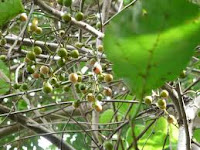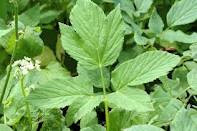As the name Creeping Jenny suggests, this plant provides good ground cover as it trails its way for up to 2 feet along the ground, and its leaves resemble coins, said to look like an old British penny, hence the name moneywort or money plant, and the Latin name nummularia. The genus name Lysimarchia may come from the name of the ancient Greek king, Lysimarchus, or else, lysis, in Greek means release from, and machia means fight, battle or strife. The plant is a member of the Primulaceae family and so is related to the cowslip, common or English primrose, oxlip, cyclamens and the scarlet pimpernel.
The plant is native to Europe and can be found in Sweden, Britain, and northern Greece through to the Caucasus. It likes to grow in wet places and I used to find it in watery ditches and hedgerows, but it also likes ponds and boggy ground and some people plant it in their ponds, although the garden varieties have golden rather than green leaves.
It used to be renowned as a wound healer, and if you place its bruised leaves on a fresh wound it will help staunch the blood and heal it more quickly. It can also be used on older wounds, and is most effective if you make an infusion from the leaves and flowers, then use this as a wash. In Mediaeval times a decoction was made with the leaves and flowers boiled in wine or water for washing wounds and sores.
In the Chinese medical system, it is used internally to remove stones from the internal organs. John Gerard, writing in the 16th century says that it was used for children’s “chinnie” coughs when boiled in wine and laced with honey. This was the term for what is now called whooping cough. It is easy to see how the corruption of chinnie became Jenny or even in some parts of Britain, Charlie, as another local name for this plant is Creeping Charlie.
It was also believed that if snakes injured themselves, they would seek out moneywort to heal themselves. This gave rise to another name for the plant “Serpentaria.”
Apart from its use as a wound healer it was also used as a diuretic so was useful in cases of gout, and because of its vitamin C content it was used to combat scurvy, which was quite common in the Middle Ages. An infusion of the whole herb was used to stop internal bleeding and because it is mildly astringent, to stop diarrhoea.
Nicholas Culpeper writing in his herbal of the 17th century had this to say about moneywort and how it could be used for health.
 “Government and virtues. Venus owns it. Moneywort is singularly good to stay all fluxes in man or woman, whether they be lasks, bloody-fluxes, bleeding inwardly or outwardly, or the weakness of the stomach that is given to casting. It is very good also for the ulcers or excoriations of the lungs, or other inward parts. It is exceedingly good for all wounds, either fresh or green, to heal them speedily, and for all old ulcers that are of spreading natures. For all which purposes the juice of the herb, or the powder drank in water wherein hot steel hath been often quenched; or the decoction of the green herb in wine or water drank, or used to the outward place, to wash or bathe them, or to have tents dipped therein and put into them, are effectual.”
“Government and virtues. Venus owns it. Moneywort is singularly good to stay all fluxes in man or woman, whether they be lasks, bloody-fluxes, bleeding inwardly or outwardly, or the weakness of the stomach that is given to casting. It is very good also for the ulcers or excoriations of the lungs, or other inward parts. It is exceedingly good for all wounds, either fresh or green, to heal them speedily, and for all old ulcers that are of spreading natures. For all which purposes the juice of the herb, or the powder drank in water wherein hot steel hath been often quenched; or the decoction of the green herb in wine or water drank, or used to the outward place, to wash or bathe them, or to have tents dipped therein and put into them, are effectual.” The herb, if it is to be dried for later use, is apparently best gathered in early July when it is still in flower.























